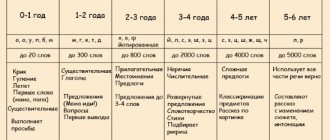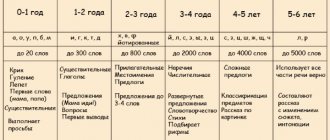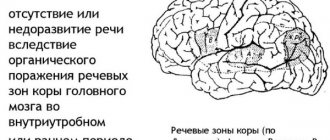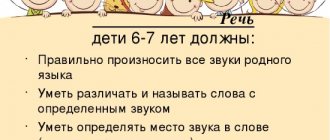If the baby has already learned to correctly pronounce the sound Ш, then you should not force him to immediately pronounce what he heard in words and sentences. Such work should take place under the guidance of a specialist - a speech therapist and includes several stages.
The following steps are being taken in this direction:
- automation of the isolated sound Ш is being worked out through repeated repetition;
- the baby tries to pronounce this sound in syllables and words;
- the sound Ш is introduced by the teacher into phrases and phrases;
- the little student pronounces it in sentences, learns to distinguish words with it in the speech of other people.
Producing the sound Shch in children
Correct pronunciation can be achieved in several ways. In the first case, the teacher starts from the sound Sh that is already familiar to the baby.
In this case, the speech therapist together with the child performs the following actions.
- He asks the fidget to raise the tip of his tongue to the upper alveoli and “hiss like a big snake.”
- The specialist draws the baby’s attention to the fact that his wide tongue in the middle part puts strong pressure on the palate, and its lateral edges are tightly pressed against the upper teeth.
- The frenulum in the oral cavity is tense, and the lips are rounded and slightly pushed forward. The teeth are slightly closed. In this position, when exhaling, the air passes into a narrow gap in the middle of the tongue. And the sound Ш smoothly turns into Ш.
The second method of production includes work that is based on the sound Ch and the syllables Si - As already existing in the child’s speech.
In this case, the work occurs in the following sequence.
- The speech therapist asks the fidget to pronounce the sound Ch for a very long time and then interrupt the exhalation.
- When a child sounds the syllables Si - As, the specialist slightly lifts the tip of a small tongue with a spatula to the alveoli of the upper teeth and gently pushes it back. As a result, the sound Shch is formed.
Automating the sound u in syllables does not present any particular difficulties for children.
I suggest the following exercises.
The sound Ш at the beginning of a word
When a child learns to pronounce a sound in isolation, he begins to repeat after the adult the syllables: Shcha, Shchu, Shche, Shche, Shchi. The automatic repetition of syllables gradually develops into words: “Shcha – Shcha – Sorrel”, “Schu – Shchu – Feel” and the like.
Games and exercises.
- Sort correctly
Multi-colored buttons of different sizes are mixed in a large container. In front of the baby there are small, medium and large plates. During the game, he is asked to put small buttons in small plates and pronounce the syllables Shche and Shche. Place medium-sized buttons in medium plates (syllable Shchu), and fill large containers with large buttons (syllable Shcha).
- I'm looking (using a sound table with the sound Ш).
The teacher offers the child pictures depicting objects, animals, fish. He says the word and asks the kid to put a chip on the corresponding picture. At the same time, he needs to carefully repeat the words: “I am looking” with emphasis on the sound. ("I'm Looking for the Brush")
The sound Ш in the middle of a word
Games and exercises.
- Be careful
The presenter names the words, and the little student claps only when he hears a word with the sound Shch. In this game you can use the following words: thicket, bast shoe, house, mouse, monster.
- Where is “ch” and where is “sch”
The game is similar to the previous one. Only in this case, if the child hears the sound Ш, he claps once. When the teacher pronounces the sound Ch, the child claps his hands twice. The teacher names the following words: repair, general, bathhouse attendant, very, dream, calculation.
The sound Ш at the end of a word
Games and exercises
- Building a house for the sound Shch
For this game you can take a construction set. The fidget is asked to put two bricks - this is the syllable Shcha. After this, add a third to the two bricks - the syllable Shchi. The fourth brick will represent Shu. And when the house of five bricks is ready, the word “ivy” will appear. You can also simultaneously invite the fidget to draw this house on paper.
- Fun buttons
The child must pronounce the word with an automated sound and at the same time press the “button” (drawn colored circle, flower, fish) with his finger. How many such “buttons” there are, so many repetitions there will be.
Words used: help, thing, cartilage, pimple and others.
Setting sounds [Ш, Ж, Ш, Ш].
Setting sounds [Ш, Ж, Ш, Ш].
Setting the sound [Ш].
METHOD 1. Setting the sound [w] from the sound [t].
- The child must make a sound for a long time [T]
, placing the wide tip of the tongue on the upper incisors, the second sound will be a whistling sound.
- Then, smiling broadly, the child should utter the sound for a long time [T]
, touching the outer surface of the alveoli with a wide tongue. Make sure that the child does not lift his tongue from the alveoli. The second sound will be a hissing sound; this sound also needs to be “aimed” at the palm.
- When pronouncing a sound for a long time [T]
The child's mouth will be slightly open (especially if he is looking in the mirror).
While the child makes a hissing sound, tell him to open his mouth slightly (place the upper incisors above the lower ones). An almost full sound [w]
. The “snake hiss” should “lay down” on the palm of your hand in a hot, wide stream. - Then the child should immediately “hiss” like a snake. When making a sound for a long time [w]
With your thumb and middle finger, press on the child’s cheeks near the corners of the mouth so that the lips protrude forward (mouthpiece).
From this sound [w]
will become completely accurate. - In the future, the child must round his lips himself (this can be done in front of a mirror).
METHOD 2. Setting the sound [w] from the correct sound [s].
Making the sound [s] with the tongue in the upper position.
- The child should place the tip of his tongue against the upper incisors (show him how to do this) and follow you in pronouncing the sound [With]
.
- If the sound [With]
If it doesn’t work, you need to start pronouncing the sound
[s]
with the tongue in a lower position and at this time move your tongue up the front teeth, moving from the lower to the upper and making sure that the sound does not change.
Final sound production [w]
.
- The child must make a sound [With]
(tongue on upper teeth).
At this time, you need to move your tongue along the palate (without lifting your tongue) towards the alveoli until the tongue is on the outside of the alveoli. At first, a fuzzy hissing sound will be heard, when the tongue reaches the alveoli, a full sound [w]
. - When making a sound for a long time [w]
Press the corners of the child’s mouth with your thumb and middle finger and push his lips forward.
- In the future, the child should round his lips independently (looking in the mirror).
METHOD 3. Setting the sound [w] from the correct sound [r].
- Let the child say the sound for a long time [R]
(lips in a smile revealing the upper and lower incisors).
- Then you need to pronounce this sound in a whisper, very quietly, so that the tongue in your mouth stops vibrating. A sound will be heard [w]
.
- Tell your child that this is how a snake hisses.
- Round your baby's lips by pressing the corners of his lips with your thumb and forefinger.
- In the future, let him round his lips independently (looking in the mirror).
METHOD 4. Setting the sound [w] with mechanical assistance.
- Let the child say the sound for a long time [With]
with the tongue in the upper position (see method 2). The lips should be in a smile that reveals the upper and lower incisors, and a small gap should be visible between the teeth.
- During such a pronunciation, you insert a spatula into the child’s mouth and, pressing it on the tip of his tongue, slowly move the tongue deeper until a sound is heard [w]
.
- In the future, let him round his lips independently (looking in the mirror).
METHOD 5. Setting the sound [sh] by showing articulation.
- Practice the articulation exercise “Cup”. As a result, he will learn to give the shape needed to pronounce a sound. [w]
.
- The child should open his mouth, make a “cup” with his tongue and lean “its edge” (the wide tip of the tongue) against the upper incisors (to their very top or slightly in front - on the outside).
- In this position, the child should “blow on the edge of the cup” (“to cool the tea poured into it”). The exhalation should be felt on the palm of your hand placed to your mouth. A vague whistling sound will be heard.
- Then the “cup” will need to be “brought” into the mouth (“so as not to spill the contents”) and the wide tip of the tongue (“edge of the cup”) placed in front of the alveoli. In this case, the “edge of the cup” should, without stopping, slide first along the inside of the upper incisors, then along the palate to the alveoli.
- All this time, the child must continue to “blow on the edge of the cup.” A fuzzy whistling sound will first be replaced by a sound [With]
, then the sound
[w]
. - When he learns to “put a cup” in his mouth and pronounce a sound [w]
, that's how the snake hisses.
- In the future, you need to immediately put the “edge of the cup” to the alveoli and “hiss.”
- During a prolonged “hissing”, round the child’s lips by pressing your fingers on the corners of his mouth. Full sound will be heard [w]
.
- In the future, the child should round his lips independently (looking in the mirror).
METHOD 5. Setting the sound [w] while inhaling.
- The child makes a sound for a long time [T]
, touching the tip of the tongue to the upper incisors and feeling the exhaled air on the palm placed towards the mouth. The upper incisors are located above the lower ones, with a small gap between them.
- Then let him exhale and make the same sound with a short inhalation. You will hear the sound of air “sucking in” against the teeth. It is important that the child does not “grasp” the air “with his throat” (then no sound will be produced), but draws it in “as if through a straw”, into the gap between the upper incisors and the tip of the tongue.
- After this, while inhaling, pronounce the sound [T]
, you need to “suck” the tongue into the depths of the mouth along with the air until it is leaning against the front surface of the alveoli. You can first feel this place with your finger.
- Point out to the child that when his tongue hits the alveoli, a “rustling” sound is heard, and a chill is felt from the fact that the air in this place rubs against the alveoli.
- Let the child immediately place his tongue on the alveoli and, while inhaling, reproduce this “rustling” sound.
- Then the child must “suck in” a little air so that a “rustle” is heard and air movement is felt on the alveoli, and then “blow” the same air back with the same “rustle” (so that the air “leaks” between the tongue and the alveoli ).
- Point out to your child that when you exhale, the “rustle” becomes more sonorous.
- After this, you need to pronounce the sound of “rustle” alternately with a short inhalation and exhalation; the movement of the air stream should be felt between the alveoli and the tongue (as it “walks” back and forth).
- While pronouncing a sound while exhaling [w]
push your child's lips forward by pressing your fingers on the corners of his mouth.
A full sound [w]
.
Production of the sound [w] in case of anomalies in the structure of the speech organs.
- If the child has signs of dysarthria
, perform articulatory gymnastics exercises with him designed to produce this sound until he develops the necessary motor skills.
- put on sound [w]
the fifth way is best.
If the child is already pronouncing the sound [s]
, you can use the fourth method. - With lower advanced bite
the sound
[w]
in the first, second, third and sixth way. To improve sound pronunciation, the tip of the tongue should be placed closer to the upper incisors (at their base) than usual. - In the same way you need to work with high palate
.
- If the child no upper molars
and they don’t grow for a long time, you can put a temporary pronunciation of the sound
[w]
.
In this case, the tip of the tongue will touch the back surface of the alveoli (sometimes the sound can also be produced when the tip of the tongue leans against the top of the alveoli). [sh]
sound will be too harsh.
The sound can be set in the first way. Then the sound [t]
must be pronounced by pressing the tip of the tongue against the inner surface of the alveoli.
You can also use the second, fourth and fifth methods. In all cases, the child will have to move the tongue deeper into the mouth than usual. You will have to rely on your own hearing: as soon as the sound [w]
, the desired point of articulation has been found.
When the child has molars, you will need to clarify with him the pronunciation of the sound [w]
.
After automating the sound [sh]
You can put the sound
[zh]
.
First, the child is given the opportunity to feel the vibration of the vocal cords when pronouncing the sound [zh]
.
The adult places the back of his hand on the front of his neck. Next, the adult, together with the child, pronounces the sound [w]
and adds a voice.
One child feels the vibration of the adult’s vocal cords, the other feels it in himself. The isolated sound [zh]
is fixed in syllables.
Setting the sound [H].
First of all, try to put the sound [h]
the first way.
METHOD 1. Setting the sound [h] from the correct sound [t`].
- The child should open his lips with a “mouthpiece” (as when pronouncing a sound [w]
), close your teeth in the form of a correct bite and quickly pronounce the syllables
[ti-ti-ti]
. The tip of the tongue should touch the palate approximately halfway between the bases of the upper incisors and the alveoli. An exhaled air stream should be felt on the palm of your hand placed towards your mouth. - You can first practice this pronunciation with your mouth open (in front of a mirror).
- While the child pronounces the syllables, you press on his cheeks with your thumb and middle finger, pressing them against the molars, and with this movement slightly push his lips forward. In this position, instead of [tee-tee-tee]
will be heard
[chi-chi-chi]
.
Warn your child that the sound of the sound [t`]
will change, and offer to see together what sound will come out. - Draw your child’s attention to this “boiling kettle” sound.
- While the child pronounces syllables [chi-chi-chi]
, release his cheeks for a while so that he continues to pronounce them independently, but if the sound
[h]
loses accuracy, again press the child’s cheeks to the molars. - After this, let the child pronounce the syllables [chi-chi-chi]
on one's own.
- Then he must pronounce the sound separately [h]
(show how a grasshopper chirps).
- When the sound is pronounced correctly, tell your child what sound he is actually pronouncing.
- In the future, train his pronunciation in syllables [che]
,
[cha]
,
[chu]
, syllables can be pronounced by imitation. - METHOD 2. Setting the sound [h] from the correctly pronounced sounds [t`] and [ш].
- Let the child put out his lips like a “horn” and pronounce sound combinations very quickly[t`sh-t`sh-t`sh]
(the air stream should be felt in the palm of your hand).
[h]
will be heard . - To clarify pronunciation, press your fingers on the child’s cheeks, pressing them against the molars.
- When the sound is pronounced freely, tell the child what sound he is making.
- In the future, train it in syllables.
Setting the sound [Ш].
First of all, try to put the sound [ш]
third way.
METHOD 1. Setting the sound [ш] from the correct sound [ш].
- The child, following you, should pronounce pairs of front-lingual sounds that differ from each other in terms of hardness and softness: [t-t`]
,
[d-d`]
,
[s-s`]
,
[z-z`]
. Explain to him that the first sound of the pair is hard, and the second is soft. - Then name the hard paired consonant, the child should call it the paired soft one.
- Then say the sound [and]
and immediately after this pronounce it softly -
[zh`]
(as if these are paired consonants on the basis of hardness and softness). Let your child repeat after you. - Invite your child to guess what soft pair sound the sound has [w]
.
If the child understands, by analogy with previous cases, to pronounce the sound [у]
- the sound is delivered. - If not, suggest to him by making a long sound [zh`]
, switch to a quiet, whispered pronunciation
[zh`-sh]
. - In the future, the child should immediately pronounce the sound [zh`]
"in a whisper."
- When the child produces a sound unmistakably, tell him what sound he is making.
- Fix the pronunciation of sounds in syllables [more]
,
[sha]
,
[schu]
,
[shche]
, syllables can be pronounced by imitation.
METHOD 2. Setting the sound [ш] from the correct sound [s`].
- The child must make a sound [s`]
with the tongue in the upper position (see the second method of making the sound
[w]
). - At this time, without stopping to pull the sound [s`]
, let him move the tip of his tongue deep into the mouth so that it is leaning against the outside of the alveoli.
The result will be the following pronunciation [s`-ш]
. - If the sound [sch]
If it doesn’t work, you can resort to mechanical assistance.
While pronouncing the sound [s`]
, press the tip of the child’s tongue with a spatula, moving it deep into the mouth until you hear the sound
[ш]
. - Warn the child that the sound should change, come up with a name for it (for example, you can say that with such noise “a wave runs onto the shore”).
- In the future, the child must independently place his tongue against the alveoli and imitate the “sound of the sea surf.”
- When he succeeds without difficulty, tell him what sound he is pronouncing.
- After this, fix it in syllables (by imitation).
METHOD 3. Setting the sound [ш] from the correct sound [h].
- Let the child make a sound [h]
.
When pronounced this way, the second sound after it will be heard [ш]
. - Draw the child's attention to the fact that after the sound [h]
another sound is heard (“similar to the sound of the sea surf”).
- Let the child draw out this second sound as long as possible.
- In the future, the pronunciation of what comes after [h]
The sound
[ш]
should be interrupted by short pauses (“as if one wave, rustling, runs onto the shore after another”). - Pauses should be lengthened so that after the combination [hch]
[sch]
sounded one after another (“as if the waves were running onto the shore less and less often”). - In conclusion, let the child immediately (without previous [h]
) will make a sound similar to the sound of the surf.
- Train his pronunciation in syllables (“teach the sea to speak”).
- After the child pronounces the sound freely, tell him what sound he is pronouncing.
Setting the sound [h] for structural anomalies of the speech organs.
- If the child has signs of dysarthria
, the sound
[h]
can be placed in any way, but the sound
[h]
is best placed using the second or third methods. - If the child It takes a long time for teeth to grow
, you can use any method.
They all rely on using the correct pronunciation of basic sounds. When making the sounds [h]
and
[h],
the child should pronounce these basic sounds as described for your case in the chapters devoted to the formation of these sounds. - With a high palate
the sounds
[ch]
and
[sch]
will sound more full if the tip touches the palate closer to the upper incisors, almost at the very base.
Literature
1. Polyakova M. A. “Self-instruction manual on speech therapy.” – M.: Iris-press, 2006.-208 p.
2. Filicheva T. B., Cheveleva N. A. “Fundamentals of speech therapy: Textbook. manual for pedagogical students. in-s on special. “Pedagogy and psychology.” - M.: Education, 1989.-223p.
3. Fomicheva M. F. “Education of correct pronunciation in children: Workshop on speech therapy.” - M.: Education, 1989.-239 p.
Word combinations and phrases starting with the sound Ш
- Teach Petrushka to speak correctly (finger theater)
The Parsley doll comes to visit the child, who tells her story and depicts the story with appropriate actions. At the same time, the narrator deliberately distorts the sound Ш in phrases and asks the little viewer to correct it.
Stories can be on the topic: “Burning Chips.” "Help to comrades."
- Catch and throw
The adult throws the ball to the baby and pronounces phrases with the given sound, and the child finishes the phrase correctly. In the game, it is advisable to use a phrase such as: “Skinny Pike live in the river.”
Presentation “Staging the sounds [CH], [SH]”
Anna Koren
Presentation “Staging the sounds [CH], [SH]”
Articulation of sound h
• Lips are rounded and slightly pushed forward;
• Teeth do not meet;
• The tip of the tongue, together with the back, forms a bridge with the upper teeth or alveoli. This bow imperceptibly passes into the gap between them;
• There is a short air stream in the middle of the tongue, which is felt by the palm of the hand brought to the mouth, like a push of air;
• The soft palate is raised, pressed against the back wall of the pharynx, closing the passage into the nasal cavity, the air stream goes through the mouth;
• The vocal folds are not tense, they are spread apart, the voice is not formed.
Exercise.
Pronouncing the sound h , transitional from the sound imitating the sound t .
Open your mouth. Raise the tip of the tongue towards the alveoli. Press the lateral edges of the tongue tightly against the upper teeth (suck the tongue to the roof of the mouth)
.
In order for the tongue to stick to the palate, the clicking
.
The teacher presses with his thumb and forefinger (from bottom to top)
on the edges of the child's tongue.
“frenulum”
is visible between the fingers .
Taking a deep breath, with a strong exhalation push, pronounce a sound imitating the sound t . The sound h will be heard .
The edges of the tongue should not tear away from the upper molars and weaken. The main difficulty is the instantaneous change of positions of the front part of the tongue and maintaining the bow between the molars and the lateral edges of the tongue. At the initial stage of sound production , you can press the edges of the tongue against the molars with your middle and index fingers.
Articulation of sound [Ш] :
• lips in a slight smile, teeth visible;
• teeth are brought together;
• the wide tip of the tongue is raised to the alveoli and forms a gap with them;
• there is an air stream in the middle of the tongue, which is easily felt by the palm of the hand brought to the mouth;
• the soft palate is raised and pressed against the back wall of the pharynx, closing the passage into the nasal cavity, the air stream goes through the mouth;
• vocal cords are open, the voice does not sound.
Exercise.
Open your mouth. Suck your entire tongue to the roof of your mouth until the frenulum
.
The tip of the tongue is raised to the front of the palate (at the alveoli)
.
The child performs this exercise with the help of a speech therapist, who places his finger under his tongue in a horizontal position. The finger should press the tongue to the palate in the middle part. Having taken in air, exhale it forcefully, pronouncing a long sound Sh . The sound SH will be heard . In this case, the tongue should spring back. The elasticity of the tongue and the gap are regulated by the speech therapist using finger pressure. It is necessary to achieve a long sound. For greater persuasiveness when pronouncing a sound, the speech therapist pronounces the sound Ш together with the child .
Note. What mistakes can there be when producing the sound ш ?
1. When exhaling (when the sound Sh )
the tip of the tongue extends from the alveoli.
A large gap is formed through which air passes. Instead of the sound Ш, the sound Ш or just a dull whistle is heard. When the exercise is performed correctly, the tip of the tongue serves as a shield that partially prevents air from passing through. a
narrower gap than when pronouncing the sound Ш. 2. The tongue should not slip from under the finger. The tip of the tongue lies at the alveoli. If the tip of the tongue slips from under the finger and moves deeper into the mouth (behind the alveoli), then the sound Ш is not heard , or is heard unclearly.
Exercise without the help of a speech therapist. The child places his finger under the tongue and presses it
Exercise in pronouncing a sound without using a finger . If this exercise does not work, it is allowed to pronounce syllables and words with a finger.
To make the sound ь, you can use the sound s. The child pronounces the syllable si or sa several times with an extended whistling element: si, si. Then the speech therapist inserts a spatula or probe under the tongue and, at the moment of pronouncing the syllables, slightly lifts it, moving it back slightly. The same acoustic effect can be achieved without lifting the tongue, but only by moving it back slightly with the touch of a spatula.
the sound H is pronounced correctly, the sound u by extending the final sound h as a fricative element. A long sound , which is subsequently easily separated from the explosive element. The sound is immediately introduced into syllables and then into words
Automation of the sound Ш in sentences
Below are examples of sentences that a child repeats after an adult.
Vegetables are stored in a box. A predatory pike caught a bream.
An example of a poem that can be learned and recited by heart.
Kotische built a huge house
And he generously gave it to the mosquito.
A feisty mosquito has settled in the house.
And he bit the poor cat.
Also, the process of automating sound will go much faster if parents and their child reinforce their pronunciation every day at home.
Conclusion. Daily exercises and the gradual introduction of sound into oral conversation will lead to clear and correct speech. Surely the ugly lisp, which so upset both the baby and his parents, will disappear. A stable pronunciation for a child aged 4–7 years can be achieved only if the child is truly carried away by the process and notices the long-awaited result.
Other articles on the site that are worth paying attention to:
“The 4th extra” is a speech therapy game. Automation of sound R
“Greedy” – a speech therapy game to automate the sound “R”
Type of speech - narration
Methods for diagnosing alalia
What exercises are useful for rhinolalic patients?
Related posts:
- The sound “Zh” - from production to automation Automation of the sound “Zh” begins with identifying the reasons that interfere with the correct sound pronunciation...
- Logorhythmic classes and correctional means By various means, speech therapy classes contribute to the effective correction of speech in children...
- A child does not know how to say R - we’ll show you how to teach it. To teach a child to pronounce the letter R, you need to regularly perform special...
- Rhoticism in speech - complete information Rhotacism (problem with the sound [P]) is the most common disorder in children...
Making the sounds sh, zh, ch, shch in several ways
Techniques for making sounds [w], [zh], [sch], [h]
Preparatory stage. In the absence of the sound [w], work begins with the formation of correct articulation of the sound: the ability to slightly push the rounded lips forward is developed; raising the wide anterior edge of the tongue to the tubercles behind the upper teeth; the ability to press the lateral edges of the tongue to the upper molars; a long-lasting air stream running down the middle of the tongue.
Staging. The technique of imitation is used and attention is paid to the correct position of the organs of the articulatory apparatus (they are asked to pronounce SA several times and during pronouncing, gradually (smoothly) raise the tongue up, the lips are slightly extended like a tube). With the mechanical method, probe No. 5 is used from the syllable SA, tongue up.
Interdental sigmatism
Preparatory stage: exercises are carried out to lift the tip and front part of the back of the tongue by the upper teeth; generation of a directed air stream; the sound [t] is practiced, which requires lifting the tip of the tongue by the upper teeth.
Staging. The child is asked, with his mouth open, to pronounce aspirated [t] 4-5 times at a slow pace, hitting the tubercles behind the upper teeth with the tip of his tongue; Gradually lengthen the exhaled stream and do not hit the tubercles, but only raise the tip of the tongue towards them.
Lateral sigmatism
Preparatory stage: exercises are carried out to strengthen the lateral edges of the tongue, uniformly lift both halves of the tip and the front part of the back of the tongue upward; producing an air stream running in the middle of the tongue; [t] and [s] are processed.
Staging. Mechanical assistance is used (probe No. 5, a flat, narrow, slightly curved handle from a teaspoon), lift the wide tongue behind the upper teeth, move it back to the tubercles, ask the child to lightly clamp the spoon with his teeth and pronounce [s] for a long time (all front teeth time are visible).
Nasal sigmatism
Preparatory stage: the ability to hold a wide, spread tongue on the upper lip is developed; direct the air stream to the tip of the tongue raised on the upper lip; to distinguish by ear the sound of [w] in nasal and oral pronunciation, [t] and [s] are practiced.
Setting [w] from [s] with mechanical assistance
If there is [p], then when pronouncing RA, use a spatula or probe No. 5 to stop the vibration of the tongue - a hissing is heard. When RA is pronounced in a whisper, SHA is heard, when pronounced loudly, ZHA is heard.
Labiodental sigmatism
Preparatory stage: the child is taught to compare and distinguish by ear [w] - [f], using pictures-symbols; exercises are carried out to practice the upward and downward movements of the lower lip; lifting the wide front edge of the tongue upward.
Staging. They put [w] by imitation, using visual control. Make sure that the lower lip is motionless and exposes the lower incisors (the lips can be held with your finger). Mechanical reception from [s] is possible.
Dental sigmatism
Preparatory stage: the ability to compare and distinguish by ear [w] - [t] is developed, using pictures-symbols; distinguish the sounds [w] - [t] based on tactile sensations of the air stream ([w] - long, [t] - jerky); exercises for long-term directed air stream; the position of the wide anterior edge of the tongue at the tubercles behind the upper incisors; processed [s].
Staging: by imitation (visual control and tactile sensations).
Hissing sigmatism
Preparatory stage: compare and distinguish [w] - [sch], using pictures-symbols; the ability to raise the wide front edge of the tongue to the tubercles behind the upper incisors; alternate movements of the wide tip of the tongue from the base of the upper incisors to the front of the hard palate (forward - backward).
Staging. From [with] a mechanical technique (pushing the tongue back).
Whistling sigmatism
Preparatory stage: compare and distinguish [s] - [w], using pictures-symbols; difference in air flow ([s] - cold, [w] - warm); upward movements of the wide tongue; alternating movements of the wide tongue for the lower - upper teeth; alternating lip movements: stretching into a smile - closed forward (tube).
Staging. Method of imitation.
The sound [zh] is made from [sh] by connecting the vibration of the vocal folds.
Among the disadvantages of pronunciation [ch], in addition to those that are common to all sibilants, it should be noted the replacement of [ch] with a soft whistling affricate [ts'], as well as the sounds [t'] or [sh'].
The sound [h] is placed from [t]: with the tip of the tongue raised upward, it is moved further inland from the upper incisors. The child is asked to pronounce Тъ-Ть or Т'И (AT') with the tip of the tongue raised upward, while pushing the lips forward. You can use probe No. 5 to retract the tip of the tongue back.
The correct pronunciation of [h] can also be achieved by pronouncing the sound combination ТШ simultaneously, first at a slow, then at a fast pace.
Among the disadvantages of the pronunciation of [sch] there is a shortened pronunciation (as with [sh]), replacement of the sound [sch] with [s'], pronunciation of [sch] with an affricative element (like the combination Ш'Ч). The sound [š] often appears automatically after [š, zh, h] are placed.
To evoke [sch], the child is asked to pronounce [sh] for a long time, stretch his lips into a smile, moving his tongue forward => [sch]. You can also ask the child to say [ch] for a long time.
A mechanical method is possible: the child pronounces S'I or S'A several times, the speech therapist inserts a spatula or probe under the tongue and, at the moment of pronouncing the syllables, slightly lifts it, moving it back a little (or simply moving it away with the touch of a spatula).
Automation of hissing sounds
The delivered sound is sequentially introduced into syllables (direct, reverse, with confluence), words and phrasal speech. With sigmatisms, they end with the stage of automation, with parasigmatisms - differentiation of [w] with substitute sounds: with [f] with labial-dental, with [t] with dental, with [sch] with hissing, with [s] with whistling parasigmatisms.








